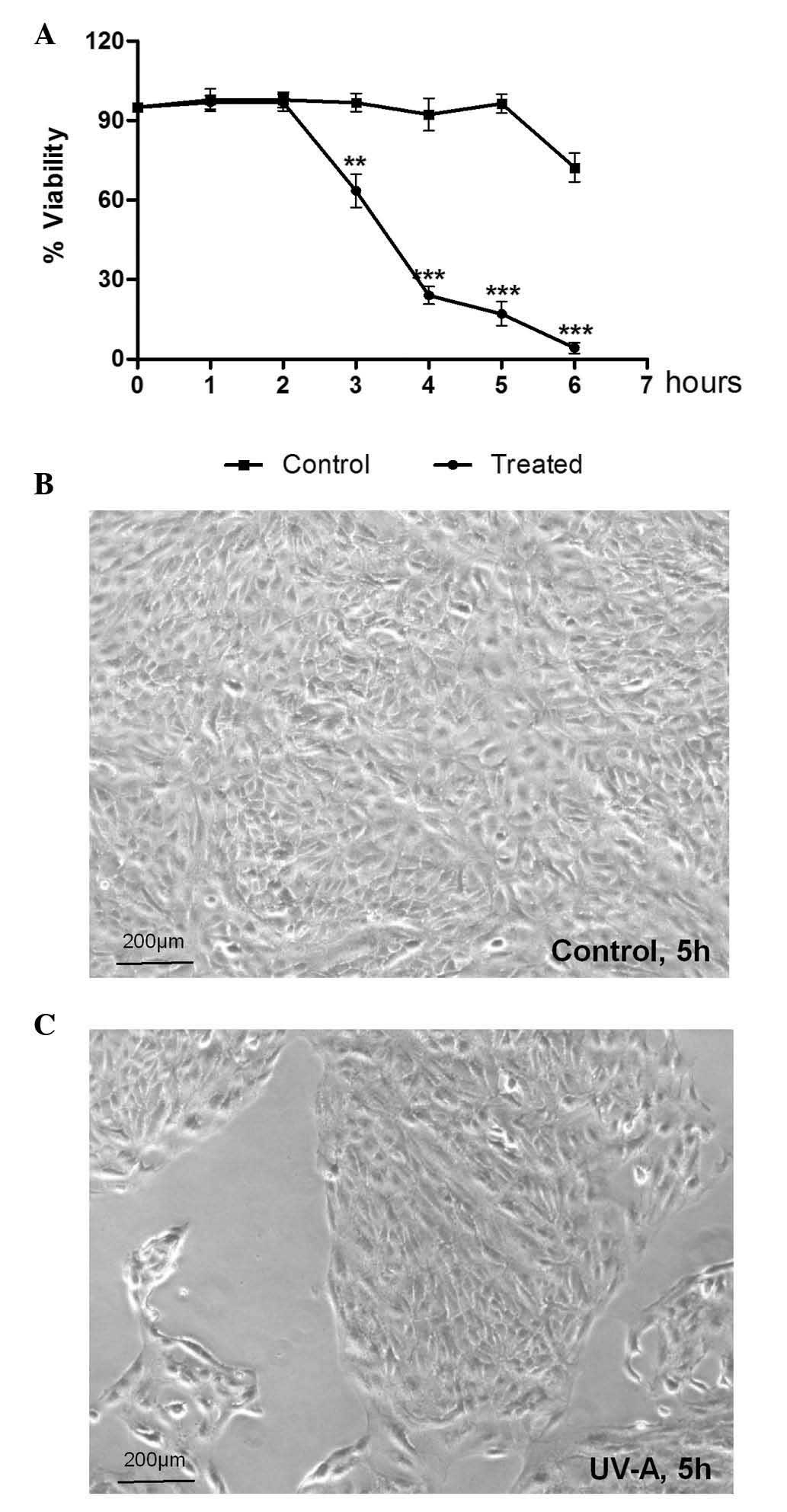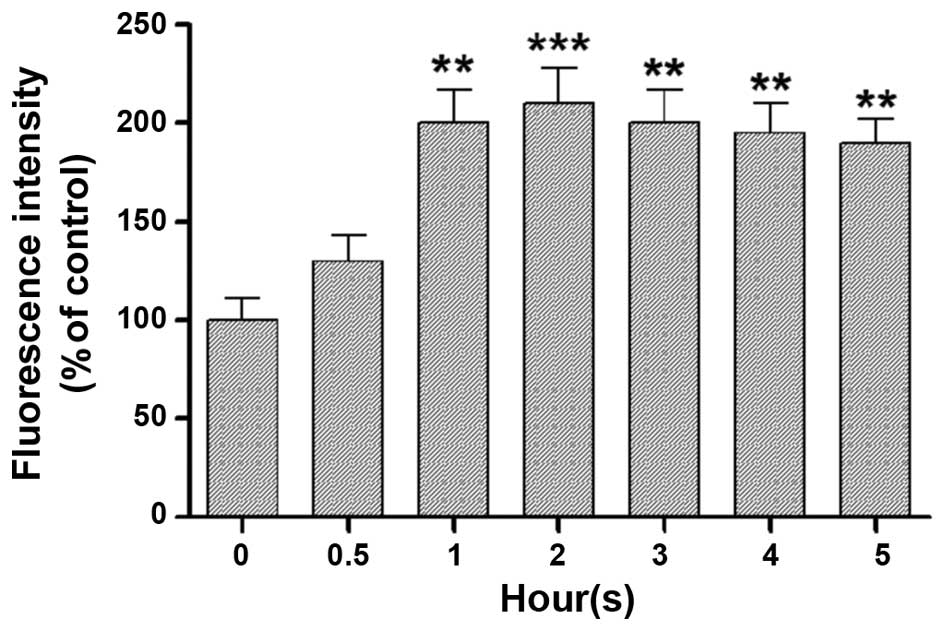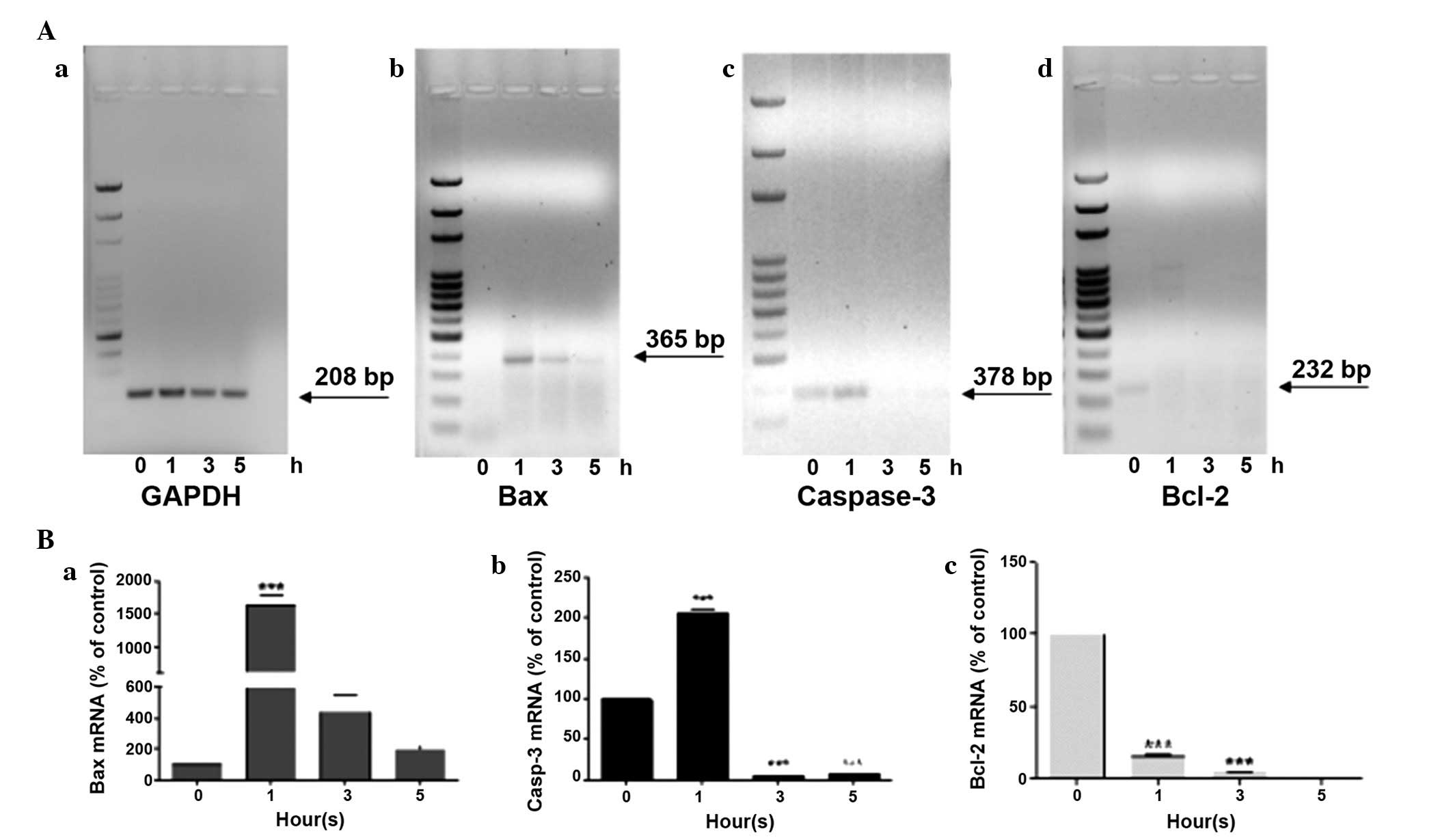Expression of early and late cellular damage markers by ARPE-19 cells following prolonged treatment with UV-A radiation
- Authors:
- Published online on: August 19, 2016 https://doi.org/10.3892/mmr.2016.5649
- Pages: 3485-3489
Abstract
Introduction
Retinal pigment epithelium (RPE) cells, which have a critical role in the neural retina, are associated with the maintenance of functional and healthy photoreceptors (1–3). These cells may be exposed to various extracellular stimuli that can promote their survival or their death through highly regulated cellular signals. Exposure to solar ultraviolet (UV) radiation is an external stressor, which induces DNA breakdown and reactive oxygen species (ROS) production (4). Under normal physiological conditions, ocular tissues express several intrinsic antioxidant enzymes, as a consequence of normal metabolism. However, during ocular injury, ROS and free radicals may be overproduced leading to the induction of pathological conditions (5). Notably, oxidative damage is associated with the pathogenesis of several degenerative ocular pathologies, including cataracts, age-related macular degeneration (AMD), glaucoma and diabetic retinopathy (6).
Exposure to solar radiation has been implicated in numerous ocular pathologies, particularly macular degeneration (7). Briefly, UV radiation can induce the production of ROS, mitochondrial dysfunction, DNA damage, and can increase apoptotic activity (8–10). The mechanism underlying UV-mediated RPE cell death is controversial and remains unclear. At present two hypotheses are the most accredited: i) Exposure to UV radiation induces the production of ROS, which may damage RPE cells through the activation of apoptotic mechanisms (11); ii) UV radiation stimulates an elevated production of ROS, which can lead to irreversible cellular necrosis (12).
Within this framework, to better understand the molecular basis and temporal sequence of the degenerative processes underlying RPE cell death following exposure to UV radiation, the present study investigated cell viability, ROS production and the expression of principal apoptotic genes in ARPE-19 cells following UV-A radiation for 5 or 6 consecutive hours.
Materials and methods
Cell culture conditions and UV exposure
The human RPE cell line (ARPE-19) was provided as a gift by Professor Stefano Cacchione (Department of Biology and Biotechnology 'Charles Darwin', Sapienza University of Rome, Rome, Italy). The cell line (CRL-2302) was originally obtained from American Type Culture Collection (Manassas, VA, USA). The ARPE-19 cell line was verified by the BMR Genomics S.r.l. Cell Line Authentication Service (Padova, Italy; ref. Nr 130264) using short tandem repeat analysis and amelogenin gender determination, as presented in Table I. As shown, the percentage match between the submitted sample and the database profile was 100%. Cells were used between passages 5 and 8.
Table IShort tandem repeat genotyping and amelogenin (AMEL) gender determination of the ARPE-19 cells used in the present study. |
The cells were cultured in 50/50 Ham's F12/Dulbecco's modified Eagle's medium (Gibco; Thermo Fisher Scientific, Inc., Waltham, MA, USA), containing 15% fetal bovine serum (Gibco; Thermo Fisher Scientific, Inc.) and 100 U/ml penicillin/streptomycin at 37°C in a humidified environment containing 5% CO2. After 1 week, the cells were passaged and plated into 6 cm cell culture dishes (1×106 cells) for further experiments. UV exposure was produced using a UV lamp (Vilber Lourmat VL-62C Power 6W; Vilber Lourmat Deutschland GmbH, Eberhardzell, Germany) in a custom-designed UV irradiation unit at 37°C and 5% CO2. UV-A exposure of the cells (at 365 nm) was conducted 10 cm from the source for 30 min, and 1, 2, 3, 4, 5 and 6 h at an intensity of ~0.06 J/cm2/sec. For minimizing absorption of radiation by the medium, a thin layer of medium was retained above the cells throughout the UV-A exposure.
Total cell count and cell viability
Following treatment of the cells, floating and attached cells were collected for analysis. A NucleoCounter (ChemoMetec A/S, Allerod, Denmark) was used to determine the total concentration of cells and viability, according to the manufacturer's protocol. The NucleoCounter uses a technique based on propidium iodide (PI) uptake and fluorescence microscopy, which is able to quantify non-viable cells and total cell concentration (13). Briefly, a mixture containing cell suspension (200 µl), lysis buffer (200 µl) and stabilizing buffer (200 µl) was loaded into the NucleoCassette, which contains the fluorescent dye PI. The cassette was then introduced into the NucleoCounter chamber for measurement of the total cell concentration. Another NucleoCassette was loaded with a sample of untreated cells to count the number of non-viable cells (based on counting PI-stained membrane-damaged cells). When the concentration of non-viable cells and the total concentration of cells were known it was possible to calculate the viability percentage of the cells, according to a formula provided by the manufacturer.
Bright-field images of the cells following UV-A exposure for various durations were obtained using a TE300 Eclipse microscope (Nikon Corporation, Tokyo, Japan) in a blind manner, and the images were digitalized using a Cool SNAP professional digital camera (Nikon Corporation) and LUCIA-G/F imaging software (Nikon Corporation). All images were acquired during one session using the same brightness setting.
Detection of ROS
ROS detection was performed after staining the cells using a 2′,7′-dichlorofluorescin diacetate (DCFDA) Cellular ROS Detection Assay kit (Abcam, Cambridge, UK). Briefly, after irradiation, cells were grown in a 96-well microplate (25,000 cells/well) and were treated successively with DCFDA for 30 min at 37°C, which is initially non-fluorescent and is converted to the fluorescent molecular DCF by oxidation. DCF was subsequently quantified using a CytoFluor Multi-well Plate Reader (Applied Biosystems; Thermo Fisher Scientific, Inc.), with 485 nm excitation and 538 nm emission filters. ROS production was expressed as fluorescence intensity.
RNA isolation and semiquantitative polymerase chain reaction (PCR)
Total RNA was isolated from the cells using the PureLink® RNA Mini kit (Thermo Fisher Scientific, Inc.). The elimination of any genomic DNA was performed using on-column DNase treatment. RNA concentration was spectrophotometrically evaluated at 280 and 260 nm. Total RNA was used for first-strand cDNA synthesis using SCRIPT cDNA Synthesis kit and Oligo-dT as random primers (Jena Bioscience GmbH, Jena, Germany) according to the manufacturer's protocol. The PCR was performed with ~200 ng cDNA using Hot Start Master (Jena Bioscience GmbH) according to the manufacturer's protocol. The following primer sequences (Invitrogen; Thermo Fisher Scientific, Inc.) were used for amplification: Glyceraldehyde 3-phosphate dehydrogenase, forward 5′-AACGGATTTGGTCGTATTG-3′, reverse 5′-GGAAGATGGTGATGGGATT-3′ (208 bp); B-cell lymphoma 2 (Bcl-2), 5′-CGACGACTTCTCCCGCCGCTACCGC-3′, reverse 5′-CCGCATGCTGGGGCCGTACAGTTCC-3′ (319 bp); Bcl-2-associated X protein (Bax), forward 5′-ACCAAGAAGCTGAGCGAGTGTC-3′, reverse 5′-ACAAAGATGGTCACGGTCTGCC (365 bp); and caspase-3, forward 5′-AGAAGATCACAGCAAAAGGAG-3′, and reverse 5′-TCAAGCTTGTCGGCATACTG-3′ (378 bp). The experimental protocols for PCR were: Denaturation, 94°C for 1 min; followed by 40 cycles of denaturation at 94°C for 1 min; annealing for 40 sec at 58°C (GAPDH), 68°C (Bcl-2), 63°C (Bax) or 60°C (caspase-3); and elongation at 72°C for 1 min; and a final elongation step at 72°C for 5 min. PCR products were analyzed by 1.8% agarose gel electrophoresis with ethidium bromide (1 µg/ml) in TBE 1X buffer (Tris 40 mM, EDTA 1 mM, boric acid 44 mM) for 2 h at 80 V (constant voltage); a 100 bp ladder was used as a molecular weight marker. Gel images were acquired (Bio-Rad Gel Doc 2000) and were scanned (Bio-Rad GS800) using Bio-Rad Quantity One software (Bio-Rad Laboratories, Inc., Hercules, CA, USA). The density of the PCR bands were divided by that of the housekeeping gene and expressed as a percentage of the control band density.
Statistical analysis
Data were analyzed by one-way analysis of variance followed by post-hoc Dunnett's test, to compare the treatment groups with the control. Data were analyzed using Prism software, version 5.01 (GraphPad, Inc., La Jolla, CA, USA). Comparison of the mean survival rates of cells exposed to UV-A radiation was made using the unpaired, Student's t-test. All results are presented as the mean ± standard error of the mean of at least three independent experiments performed in duplicate, unless otherwise specified. P<0.05 was considered to indicate a statistically significant difference.
Results
The present study examined a sequence of molecular and biological events induced by prolonged and continuous treatment of ARPE-19 cells with UV-A. Preliminary experiments were conducted to investigate cellular viability following exposure to UV radiation for various durations (0.50, 1, 2, 3, 4, 5 and 6 h). Treatment with UV-A radiation resulted in a time-dependent decrease in cellular viability from 2 h onward, compared with the non-irradiated controls (70, 20 and 10% viability at 3, 4 and 5 h, respectively) (Fig. 1A). Cell death was detected morphologically after 5 h irradiation, as follows: i) A marked reduction in the number of living cells; ii) cells were obviously swollen and loss of plasma membrane integrity was detected (Fig. 1C).
A second series of experiments were performed to ascertain whether the reduction in cellular viability observed post-irradiation was associated with oxidative stress, since various studies have suggested that ROS generation may be an underlying cause of RPE cell death (4–6). A significant and consistent increase in ROS levels (200% increase) was observed after 1 h UV-A irradiation in the experimental paradigm. These levels remained constant throughout the subsequent time-points (Fig. 2).
By this stage of the present study, the involvement of ROS in the irradiation-induced reduction of cellular viability had been confirmed; therefore, additional experiments were conducted to determine the underlying molecular mechanism(s) by which ROS caused this effect. In this regard, the expression levels of principle apoptotic (Bax and caspase-3) and anti-apoptotic (Bcl-2) genes were detected in our experimental model after 1, 3 or 5 h of UV-A exposure.
After 1 h of treatment an overexpression of Bax was detected, which dropped drastically at 3 h, until reaching values similar to those of the untreated controls after 5 h (Fig. 3Ab and Ba). An analogous trend was also observed in the gene expression levels of caspase-3 (Fig. 3Ac and Bb); after 1 h of UV-A treatment its expression doubled, compared with at 0 h; however, the expression almost disappeared from 3 h onward. Notably, ARPE-19 cells exhibited caspase-3 gene expression at 0 h. Finally, the expression levels of the anti-apoptotic gene Bcl-2 were detected. Bcl-2 was exclusively expressed in untreated cells at 0 h, whereas it was expressed at low levels in cells following exposure to UV-A radiation for various durations(Fig. 3Ad and Bc).
Discussion
Knowledge of the numerous functions performed by RPE cells has improved the understanding of several diseases that lead to blindness. The RPE layer is one of the major ocular tissues known to be metabolically active and sensitive to oxidative stress. The balance between oxidative stress and cellular death may be responsible for the progression of several diseases of the underlying retina, including AMD. However the molecular events that correlate with ROS generation and cellular death in RPE cells remain partially unclear. Notably, contrasting evidence has been reported in the literature in recent years. In particular, some studies have reported that RPE cells exposed to UV undergo apoptotic cell death (11,14), whereas other studies have claimed that apoptosis is not the main mechanism of RPE cell death (12,15), thus indicating that necrosis may be responsible for RPE cell death in response to oxidative stress.
The present study aimed to elucidate these mechanisms by describing the sequence of molecular events that occur after continued exposure to UV-A radiation. UV-A exposure for 5 consecutive hours induced cytotoxic effects due to the production of high levels of ROS. After 1 h irradiation, ROS levels were markedly increased and induced an increase in the expression of apoptotic genes (Bax and caspase-3), and decreased the expression of the anti-apoptotic gene, Bcl-2. Subsequent hours were characterized by a marked decrease in Bax and caspase-3 expression, whereas ROS levels remained high and constant. Notably, during this time range cell viability continued to rapidly decline, and in the last hour the observed morphological features of the cells suggested that they were undergoing necrosis.
The present study hypothesized an intermediary role for oxidative stress in the induction of apoptosis, since molecular events observed leading to Bax and caspase-3 activation were induced by initially increasing levels of ROS. Conversely, when ROS levels remained consistently high, apoptotic gene expression was suppressed and RPE death appeared to occur by necrosis. Consistent with this hypothesis, previous studies have reported that low levels of ROS upregulate apoptotic genes and downregulate anti-apoptotic genes in cells, leading to apoptotic cell death (16,17), whereas high levels of ROS can lead to lipid peroxidation, cellular membrane damage, inactivation of caspases and necrotic cell death (18).
To the best of our knowledge, the present study is the first to describe the sequence of molecular events that occur following continuous exposure to UV-A radiation. UV-A induced an increase in ROS levels, which initially led to activation of apoptotic events, followed by the induction of irreversible cellular necrosis. These findings, even if preliminary, may be useful for improving understanding regarding the oxidative damage that underlies UV-induced ocular cell damage.
In conclusion, the results of the present study are the first, to the best of our knowledge, to describe the sequence of cellular events starting from the first 30 min of UV-A treatment. UV-A radiation induced the activation of apoptotic events and subsequently led to irreversible cellular necrosis. These important findings may have future pharmacological applications in protecting RPE cells from the initiation and progression of UV-A-induced ocular disorders.
Acknowledgments
The authors of the present study would like to thank Professor Stefano Cacchione and Dr Sara Luzzi (Department of Biology and Biotechnology 'Charles Darwin', Sapienza University of Rome, Rome, Italy) for providing the ARPE-19 cells. They would also like to thank Dr Lucia Lisi for her contribution to the experimental work described. The present study was financed by the Italian National Research Council (CNR) and UCSC internal funding (Fondi di Ateneo 2013 to G.T.).
References
|
Kuznetsova AV, Kurinov AM and Aleksandrova MA: Cell models to study regulation of cell transformation in pathologies of retinal pigment epithelium. J Ophthalmol. 2014:8017872014. View Article : Google Scholar : PubMed/NCBI | |
|
Rizzolo LJ: Barrier properties of cultured retinal pigment epithelium. Exp Eye Res. 126:16–26. 2014. View Article : Google Scholar : PubMed/NCBI | |
|
Pfeffer BA and Philp NJ: Cell culture of retinal pigment epithelium: Special Issue. Exp Eye Res. 126:1–4. 2014. View Article : Google Scholar : PubMed/NCBI | |
|
Glickman RD: Ultraviolet phototoxicity to the retina. Eye Contact Lens. 37:196–205. 2011. View Article : Google Scholar : PubMed/NCBI | |
|
Blasiak J, Petrovski G, Veréb Z, Facskó A and Kaarniranta K: Oxidative stress, hypoxia, and autophagy in the neovascular processes of age-related macular degeneration. Biomed Res Int. 2014:7680262014. View Article : Google Scholar : PubMed/NCBI | |
|
Tu G, Zhang YF, Wei W, Li L, Zhang Y, Yang J and Xing Y: Allicin attenuates H2O2-induced cytotoxicity in retinal pigmented epithelial cells by regulating the levels of reactive oxygen species. Mol Med Rep. 13:2320–2326. 2016.PubMed/NCBI | |
|
Plestina-Borjan I and Klinger-Lasić M: Long-term exposure to solar ultraviolet radiation as a risk factor for age-related macular degeneration. Coll Antropol. 31(Suppl 1): 33–38. 2007.PubMed/NCBI | |
|
Li X, Zhao H, Wang Q, Liang H and Jiang X: Fucoidan protects ARPE-19 cells from oxidative stress via normalization of reactive oxygen species generation through the Ca2+-dependent ERK signaling pathway. Mol Med Rep. 11:3746–3752. 2015.PubMed/NCBI | |
|
Øsnes-Ringen O, Azqueta AO, Moe MC, Zetterström C, Røger M, Nicolaissen B and Collins AR: DNA damage in lens epithelium of cataract patients in vivo and ex vivo. Acta Ophthalmol. 91:652–656. 2013. View Article : Google Scholar | |
|
Ji Y, Cai L, Zheng T, Ye H, Rong X, Rao J and Lu Y: The mechanism of UVB irradiation induced-apoptosis in cataract. Mol Cell Biochem. 401:87–95. 2015. View Article : Google Scholar | |
|
Roduit R and Schorderet DF: MAP kinase pathways in UV-induced apoptosis of retinal pigment epithelium ARPE19 cells. Apoptosis. 13:343–353. 2008. View Article : Google Scholar : PubMed/NCBI | |
|
Hanus J, Zhang H, Wang Z, Liu Q, Zhou Q and Wang S: Induction of necrotic cell death by oxidative stress in retinal pigment epithelial cells. Cell Death Dis. 4:e9652013. View Article : Google Scholar : PubMed/NCBI | |
|
Shah D, Naciri M, Clee P and Al-Rubeai M: NucleoCounter-An efficient technique for the determination of cell number and viability in animal cell culture processes. Cytotechnology. 51:39–44. 2006. View Article : Google Scholar | |
|
Chan CM, Huang CH, Li HJ, Hsiao CY, Su CC, Lee PL and Hung CF: Protective effects of resveratrol against UVA-induced damage in ARPE19 cells. Int J Mol Sci. 16:5789–5802. 2015. View Article : Google Scholar : PubMed/NCBI | |
|
Murakami Y, Matsumoto H, Roh M, Giani A, Kataoka K, Morizane Y, Kayama M, Thanos A, Nakatake S, Notomi S, et al: Programmed necrosis, not apoptosis, is a key mediator of cell loss and DAMP-mediated inflammation in dsRNA-induced retinal degeneration. Cell Death Differ. 21:270–277. 2014. View Article : Google Scholar : | |
|
Hildeman DA, Mitchell T, Aronow B, Wojciechowski S, Kappler J and Marrack P: Control of Bcl-2 expression by reactive oxygen species. Proc Natl Acad Sci USA. 100:15035–15040. 2003. View Article : Google Scholar : PubMed/NCBI | |
|
Han S, Lu Q and Wang N: Apr3 accelerates the senescence of human retinal pigment epithelial cells. Mol Med Rep. 13:3121–3126. 2016.PubMed/NCBI | |
|
Kannan K and Jain SK: Oxidative stress and apoptosis. Pathophysiology. 7:153–163. 2000. View Article : Google Scholar : PubMed/NCBI |












